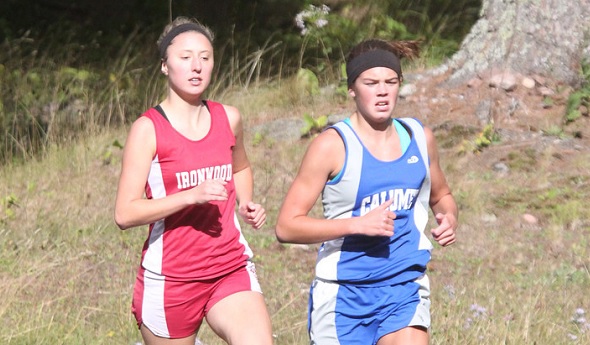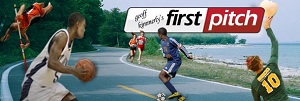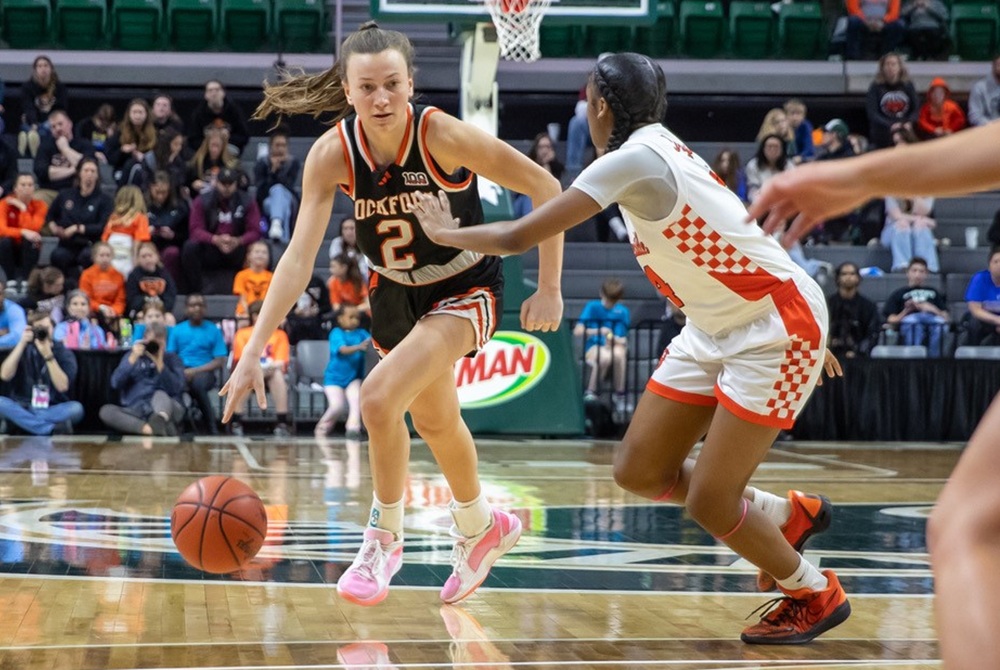
Calumet Invite Produces Northern Stars
September 18, 2013
By Geoff Kimmerly
Second Half editor
The Calumet Invitational dates back roughly 30 years as an annual staple of the cross country schedule for schools at the northernmost tip of Michigan's Upper Peninsula.
A creative move by the Copper Kings last year added some statewide prestige to the event.
 Last week, for the second season, Calumet ran the series of races at Keweenaw Mountain Lodge, a resort near Copper Harbor and the northern bank of the Keweenaw Peninsula.
Last week, for the second season, Calumet ran the series of races at Keweenaw Mountain Lodge, a resort near Copper Harbor and the northern bank of the Keweenaw Peninsula.
Calumet is the northernmost high school in Michigan. And moving this race another 35 miles northeast more or less guaranteed it's the northernmost event run in the state.
"We figured it was pretty safe. We're the northernmost school in the state, and you can only go four more miles and you're in Lake Superior," Calumet athletic director Sean Jacques said. "Nobody else is going to do anything more north than that."
A total of 10 schools were represented this fall in the races for boys and girls varsity, junior varsity and middle schoolers.
Jacques said the event formerly was run at a golf course in Calumet. But a few years ago, Calumet graduate and former Copper Kings cross country runner Dan Harri moved home from Florida to become general manager at the Mountain Lodge (he's also a renowned chef and has owned restaurants in Miami with Hall of Fame Dolphins coach Don Shula).
Harri had asked a few times about bringing a cross country or golf event to the lodge. Jacques told him last year they'd give it a try, so Harri set up a course that includes golf course, a couple of bridges, trails and finishes with a climb on the No. 1 fairway. It also provides various points for fans to watch runners go by, not always available on other courses.
"We were looking for a little bit of a change, and it's a beautiful course," Jacques said. "We thought if people were willing to make the extra drive, it would be really nice."
Calumet won the boys race this season, just ahead of runner-up Houghton. Houghton's girls were victorious, followed by the host Copper Kings.
Click to read more about this year's event from the Houghton Mining Gazette.
Michigan's claim to an NFL evolution
As part of its NFL preview this month, Sports Illustrated reported on one of the most significant developments for offenses over the last few decades – the silent snap count, which is used regularly by visiting teams because offensive linemen can’t hear the quarterback calling for the ball over the clamor of the home crowd.
And the article explained that the silent snap count might’ve gotten its start at one of Michigan’s smallest high schools – Flint’s Michigan School for the Deaf.
Offensive linemen during the 1980s were feasted on by pass rushers like Lawrence Taylor and Bruce Smith, who built record sack totals by blasting past blockers who seemed a step slow. Turns out, that was true. Defensive players were getting an edge by attacking as soon as they saw the ball move. But blockers (especially offensive tackles), focused instead on the defensive ends and linebackers lined up across from them, and didn’t have the luxury of watching the ball – and since they also couldn’t hear the snap count, started each play a step behind.
Enter the silent count. The quarterback signals to the center that he is ready to receive the ball (with a pat on the back, by raising a foot, etc.). The center then raises his head, and after a predetermined count of at least one second snaps the ball without a sound. This means an offensive tackle doesn’t have to listen for a snap count – he just counts after seeing the center get set.
The SI report recognized longtime offensive line coach Howard Mudd as the guru of the silent snap count. But Mudd recalled a conversation he’d had while working for the Seattle Seahawks with another coach, the late Andy MacDonald, who also had coached early in his career at a school for the deaf in Michigan.
The article doesn’t mention Michigan School for the Deaf by name. But it seems to make sense that the Tartars were the first to use the now-revolutionary count. MacDonald – who played at Central Michigan University and went on to coach at Michigan State and four other colleges and also for the Buffalo Bills – grew up in Flint and attended Flint Northern before playing for the Chippewas from 1950-53. The historical web site Michigan-football.com has results for Flint’s Michigan School for the Deaf dating to 1950, making it a decent assumption that MacDonald might’ve gotten in a little early coaching experience at the school down the road from his home.
Click for the SI story and go to page 4 for the mention of Michigan’s school.
Michigan mourns trooper, running standout
The law enforcement community is mourning the death of Michigan State Police trooper Paul Butterfield, who was shot Sept. 9 during a traffic stop in Mason County. He also was a well-known distance runner during the 1980s and the MHSAA Class A cross country champion running for Bridgeport in 1987.
According to a Ludington Daily News report, Butterfield continued running after high school at the University of Tennessee, and also competed at the 1989 Pan American Junior Games in Argentina.
Butterfield was stationed in Hart after previously serving in Manistee, and lived in Mason County. He also had served in the U.S. Army. Click to read more from the Ludington Daily News.
PHOTO: Calumet's Chelsea Jacques (right) won this season's Calumet Invitational with a time of 21:08.06, just ahead of Ironwood's Jessica Gering at 21:46.16. (Photo courtesy of Calumet athletic department.)

Rockford's Miss Basketball Caps Career Among State's Top Shooters, All-Time Winners
By
Geoff Kimmerly
MHSAA.com senior editor
December 19, 2025
Rockford’s Anna Wypych finished her high school career in March with four record book listings earned during her four-year varsity career and Miss Basketball Award-winning senior season.
She made 94 3-pointers last winter, good for fifth all-time, and finished her career with 203. She also made the career games played list with 107 and career wins list helping the Rams to a 99-8 record. Rockford won the Division 1 championship in 2023, finished runner-up last winter and also made the Semifinals when Wypych was a freshman and junior.
She’s continuing her career this season at Butler.
See below for several recently-added listings to the girls basketball record book, and click the heading to see the record book in full. Several more applications have been received and are in the process of being confirmed.
Girls Basketball
Mia McGregor is up to 26 listings in the record book after her first two seasons at Mio. Her 58 points in a game against St. Helen Charlton Heston as a freshman is tied for ninth and one of her 12 games scoring 45 or more points. Her 866 points (41.2 ppg average) that debut season rank second all-time, and she’s already on the career 3-pointers (160) and free throw (345) lists. She also made the single-game assists list with 14 against Atlanta last season.
Jaxi Long’s heroics at the end of a 61-54 win over Muskegon Western Michigan Christian on Jan. 4, 2022, have her second on a record book list. She scored 29 points, including 22 in the fourth quarter, as Newaygo came back from an 11-point deficit that period. She’s playing at Cornerstone.
Baraga senior Kara Roberts made the single-season 3-pointers list as both a sophomore (74) and junior (70). Baraga as a team also made multiple 3-pointer lists over the last few seasons, including with 13 in a game last winter. Roberts has committed to continue at Wisconsin-Eau Claire.
Morrice’s Aubrey Rogers totaled 20 steals during a Feb. 2, 2024, win over Burton Bendle, tying for second-most in one game. She was a senior and has continued at Spring Arbor.
Ishpeming’s march to the Division 4 championship in 2024 includes several record-book accomplishments as a team and individually. As a team, Ishpeming tied the single-season record of 28 wins in finishing 28-1, and made lists with 195 3-pointers and 710 attempts from beyond the arc. Then-junior Jenessa Eagle made the record book with 72 of those 3-pointers. She has signed with Michigan Tech.
Evart junior Kyrah Gray made the single-season steals list with 15 in a Dec. 6, 2024, game against Beal City, and finished the season with 188 over 25 games – the season total ranking fifth all-time.
Averie Zinn has entered her senior season at Genesee with 20 record book listings – and a chance to add several more. Zinn’s best from her first three seasons included 851 points scored (32.7 per game) last winter, which rank third all-time; 186 free throws last season, which rank 10th; and 218 steals also from last season that rank third on that list. She has committed to Wayne State.
Charlotte senior Peyton Howarth cemented her name in the record book with nine 3-pointers in a Dec. 7, 2024, game against Quincy. She finished with 29 points.
Vivian Idziak earned Grand Rapids Union’s first record book entry in this sport with 15 blocked shots against Muskegon Reeths-Puffer on Jan. 16, 2024, and added a second with 27 rebounds against Wyoming Kelloggsville this past Feb. 25. She graduated this spring and will continue at Grand Rapids Community College, where she will run cross country.
Braxcynn Baker finished her Lowell career in 2024 with several record book listings, including for 183 free throws (in 223 attempts) as a senior and 479 free throws (ranking eighth) in 587 attempts with an .816 percentage for her career. She also made the career 3-pointers list with 180 over 91 games. Her senior-season free throws contributed significantly to Lowell’s MHSAA-record 319 over 25 games that season. She’s continuing her career at Murray State.
Orchard Lake St. Mary’s earned its first girls basketball record book listings during the 2023-24 season. As a team, the Eaglets made 171 3-pointers in 487 attempts – both totals making lists – and Allie Crighton made the single-season free-throw shooting list by connecting on 87 percent of her attempts. She’s a junior and has committed to Northwood.
Fallon Behrick launched a quick start on her 32-point night for Otisville-LakeVille Memorial against Mt. Morris on Jan. 23. The senior scored 21 first-quarter points to make the single-quarter scoring list.
Milan’s Emily Bladen scored 39 points on Dec. 10, 2024, against Britton Deerfield, with 27 coming on nine 3-pointers as she made that single-game list. She’s currently a junior.
Parc Liggins also earned a spot on the single-game 3-pointers list with 10 in 14 attempts for Grand Blanc against Lapeer on Jan. 24. She’s a senior this winter.
Parchment’s 61-30 win over Delton Kellogg on Jan. 28 saw the winning team tie for the sixth-most 3-pointers made in one game – 17 – while also making the single-game attempts list with 47.
Adelyn Moore finished her career at Caro in 2023 by making single-season lists with 150 steals and 336 rebounds – and also career lists with 442 steals and 1,047 rebounds over four seasons and 80 games. She played a season at University of Chicago and is now at Denison in Ohio.
Kent City added to its growing list of top 3-point performances when it connected on 16 – on only 37 attempts – in a Feb. 11 game against Howard City Tri County.
White Cloud’s Alexis Strait tied for the fourth-most 3-pointers in a game when she made 11 on the way to scoring 37 points total on Feb. 7, 2020, against Hesperia. She was a junior that season.
Tamerah Peterson capped her Sterling Heights Parkway Christian career last winter with 633 steals – good for second on the career list – over four seasons and 86 games. Her 213 steals as a sophomore rank fourth for a single season. She was joined in the records by now-junior Angelina Marchesi, who made the single-season rebounds list with 312 over 24 games. Peterson is running track at Spring Arbor.
Merrill’s Maddy Desmyter entered her senior season with a record book entry after grabbing 316 rebounds over 23 games last winter. She has committed to Adrian College.
Twice over five days in February, Analeis Ming made the single-season assists list with two of the highest-ranking performances in state history. She had 15 assists in Au Gres-Sims’ game Feb. 13 against Atlanta and 17 steals on Feb. 17 against Fairview. She is a senior and has committed to play soccer at Knox College in Illinois.
Jayna Schwartz capped her Battle Creek Calhoun Christian career last winter with 73 3-pointers over 21 games, making that single-season list. She just missed the single-season list as a junior with 64.
Madeline Pier tied for 13th all-time on the single-game rebounds list when she grabbed 30 in Swartz Creek’s win over Flint Kearsley on Jan. 31. She’s a junior.
Saline’s Keira Roehm drained 100 3-pointers last winter – third-most in MHSAA history – and had 238 entering her senior year to already rank 12th on the career list after 73 games. She contributed significantly to Saline’s team total of 174 over 24 games. She’s committed to Wayne State.
Hanna Vaughn added 46 more 3-pointers as a senior last season to finish her four-year Ironwood career with 201 over 92 games. She’s playing volleyball and basketball at Gogebic Community College.
Nearly 50 years later, the longest overtime game in MHSAA girls basketball history has been uncovered. Michigan Center defeated Grass Lake 57-50 in six overtimes on Oct. 11, 1978. Coincidentally, Michigan Center also played in a five-overtime game that was tied for the record before this result was added to the top of the list.
Niles Brandywine added to its several listings for 3-pointers attempted and made, connecting on 198 of 689 attempts over 28 games last season. Both rank among the top 15 in their respective categories.
Victoria Hauffe has entered her senior season at Hemlock already on the career 3-pointers list with 159 over her first three seasons and after connecting on 69 last winter. Hemlock as a team was added to the records for making 13 3-pointers against Essexville Garber last December and attempting 529 over 25 games.
Dena Droste played four varsity seasons for DeWitt through graduation in 2011, and finished on the career 3-pointers list with 152 in 415 attempts. She went on to play at Kent State and Ferris State.
PHOTO Rockford's Anna Wypych (2) makes a move toward the lane during last season's Division 1 championship game.

